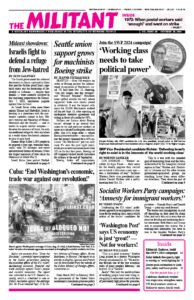“This is a great economy,” Heather Long gushed in a feature Washington Post op-ed column Oct. 10. “We are living through one of the best economic years of many people’s lifetimes,” she insisted. It’s a “miracle.”
Really? This isn’t the world millions of working people have been living in, struggling to make ends meet in the face of persistently high prices for groceries, rent or mortgages, electric bills, gas, health care, credit card debts and much more.
This real-world reality is rooted in the deepening economic, social and moral crisis of capitalism.
The consumer price index rose 2.4% from a year earlier in September, the Labor Department reported Oct. 10. While the monthly pace of price increases has slowed over the past year, the prices of just about everything essential to workers remain much higher than they were four years ago. And they’re not coming down.
“Politicians and economists crow about reducing inflation to two to 3%,” Gerald Kaminski, 69, a retiree in Palatine, Illinois, told the Wall Street Journal, “but that’s on top of 20% inflation over the prior years. They think that’s good and it’s not.”
Neither Democrat Kamala Harris nor Republican Donald Trump offer any answers to the way the capitalist economic crisis is battering workers and their families. Like Heather Long, Harris claims “we’ve” turned the corner. But there is no “we.” The capitalist rulers and their meritocratic hangers-on may be doing swell, but working people aren’t. Trump offers only vague promises that if he’s in the White House, things will get better.
While those seeking to buoy the sagging Democratic election chances insist inflation is no longer an issue, their statistics are based on averages of all purchases — from Rice Krispies and pampers to yachts and private jets.
The capitalist ruling families don’t worry much about prices. For instance, two of the feature ads in the Oct. 13 New York Times magazine offer Oyster Perpetual Day-Date 36 Rolex watches — which go for $149,999 a pop new, $54,999 used, at jaztime.com — and a nice bottle of Lagavulin Islay single malt Scotch, just $145 at Bottle Buzz.
But workers face more serious problems. In September food prices — which government economists don’t count in their favored “core” inflation statistics — posted their biggest monthly gain so far this year. Eggs rose 8.4%, up nearly 40%. Prices for clothing, car insurance, furniture and airfares also went higher.
“The [Biden] administration’s policies have caused more harm to the people we serve in terms of the number of people coming in,” Ken Estelle, president of Feeding America in west Michigan, told the Financial Times. Visits to his food pantries rose by more 20% over the past year, after a nearly 30% increase the year before, he said. “It is hard to overcome the prior three years of really disabling prices.”
It’s “sticky inflation,” writes New York Sun columnist Lawrence Kudlow, because prices that have soared are not going down. “There are big soft spots in the economy, particularly manufacturing and housing, which are both in recession,” he adds.
Brutal high prices are a major issue for working people worldwide. In September food prices around the globe rose at their fastest rate in 18 months, the Food and Agriculture Organization of the United Nations said. The biggest jump was for sugar, up 10.4%. Cereal prices rose 3%, reflecting jumps in wheat and corn export prices.
Well-paid full-time jobs hard to get
Despite the government’s announcement that 254,000 jobs were created in September, which it says shows the capitalist economy is doing great, millions of workers know all too well that decent well-paid jobs are hard to come by. The Labor Department says there are 5.7 million people who want a job, but aren’t counted as part of the labor force because they’ve given up looking. There are also 4.6 million workers who want full-time jobs but have only been able to find part-time hours, with less pay, benefits or union representation.
The number of workers forced to take on a second job to cover family expenses is also rising. It’s up to 8.6 million, 5.3% of the workforce.
For the first week in October the number of workers who filed unemployment claims rose to the highest level in more than a year. And the number of workers unemployed for 15 weeks or longer is also up.
Health care costs continue to rise, as insurance companies, hospitals and the entire medical for-profit industry focus on how to maximize their take. Average family insurance premiums cost $6,296 last year, said the KFF health research group.
A Mercer survey reported the cost of employer-provided health insurance rose by 7% in 2024 for the second straight year and will go up an average of 5.8% in 2025.
Workers face higher medical deductibles, in some cases thousands of dollars for both themselves and their families. The average deductible for single coverage has grown “faster than workers’ wages in the past decade,” KFF says.
The government announced Oct. 10 that Social Security payments will increase by only 2.5% in 2025, the smallest cost-of-living adjustment in four years. This is way below the higher costs all workers face, and much higher costs seniors face for health care, drugs, food and rent. Some 40% of older workers rely on Social Security for half or more of their income.
And this paltry increase will be immediately reduced by the government boosting the monthly cost for Medicare.

